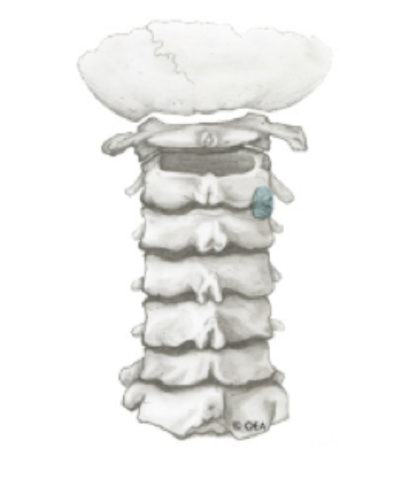Cervical Spine Injections
Cervical Facet Medial Branch Nerve Blocks and RFA
For Chronic Neck Pain and Headache
A cervical medial branch block is an outpatient procedure for diagnosing and treating neck, shoulder upper back and headache. This information sheet will explain what it is. Your doctor can explain if it is for you.
What are cervical facet joints?
 Facet joints connect the vertebrae, the bones of the spine. They help guide your spine when you move. The neck area of the spine is called the cervical region. It contains seven vertebrae. Facet joints are found on both sides of the spine. Each is about the size of a thumbnail. Cervical facet joints are named for the vertebrae they connect and the side of the spine where they are found. The right C2-3 facet joint, for example, joints 2nd and 3rd vertebrae on the right side. Medial branch nerves are found near facet joints. They transmit pain signals from the facet joints to your brain.
Facet joints connect the vertebrae, the bones of the spine. They help guide your spine when you move. The neck area of the spine is called the cervical region. It contains seven vertebrae. Facet joints are found on both sides of the spine. Each is about the size of a thumbnail. Cervical facet joints are named for the vertebrae they connect and the side of the spine where they are found. The right C2-3 facet joint, for example, joints 2nd and 3rd vertebrae on the right side. Medial branch nerves are found near facet joints. They transmit pain signals from the facet joints to your brain.
What is cervical facet joint pain?
 You may feel pain if a cervical facet joint is injured. Sometimes it feels like muscle tension. Other times it can be severe pain. The cartilage inside the joint may be injured. Other times only connecting ligaments surrounding the joint are injured. Facet pain also depends on which facet joint is affected.
You may feel pain if a cervical facet joint is injured. Sometimes it feels like muscle tension. Other times it can be severe pain. The cartilage inside the joint may be injured. Other times only connecting ligaments surrounding the joint are injured. Facet pain also depends on which facet joint is affected.
How do I know if I have cervical facet pain?
If you have pain in one or more of these areas, and it last longer than two months, you may have cervical facet pain. Common tests such as x-rays or MRIs may not always show if a facet joint is causing pain.
What is a cervical medial branch block?
 In a cervical medial branch block, a local anesthetic (numbing medicine) is injected near the medial branch nerve. This stops the Cervical medial branch transmission of pain signals from the facet joint. If this reduces your pain and helps you move your neck like normal, it may tell the doctor which facet joint is causing the pain.
In a cervical medial branch block, a local anesthetic (numbing medicine) is injected near the medial branch nerve. This stops the Cervical medial branch transmission of pain signals from the facet joint. If this reduces your pain and helps you move your neck like normal, it may tell the doctor which facet joint is causing the pain.
What is a cervical RFA(radio frequency ablation)?
RFA uses radiofrequency energy to disrupt nerve function. When this is done to a cervical medial branch nerve, the nerve can no longer transmit pain from an injured facet joint.
What happens during an RFA?
A local anesthetic will be used to numb your skin. The doctor will then insert a thin needle near the facet joint. Fluoroscopy, a type of x-ray, must be used to position the needle. The doctor will then check to make sure it is at the correct nerve by stimulating it. This may cause muscle twitching and provoke some of your pain. Once the needle is properly placed, the nerve will be numbed. Radiofrequency energy will then be used to disrupt the medial branch nerve. This is not a permanent procedure and frequently the nerve recovers over a period of time.
